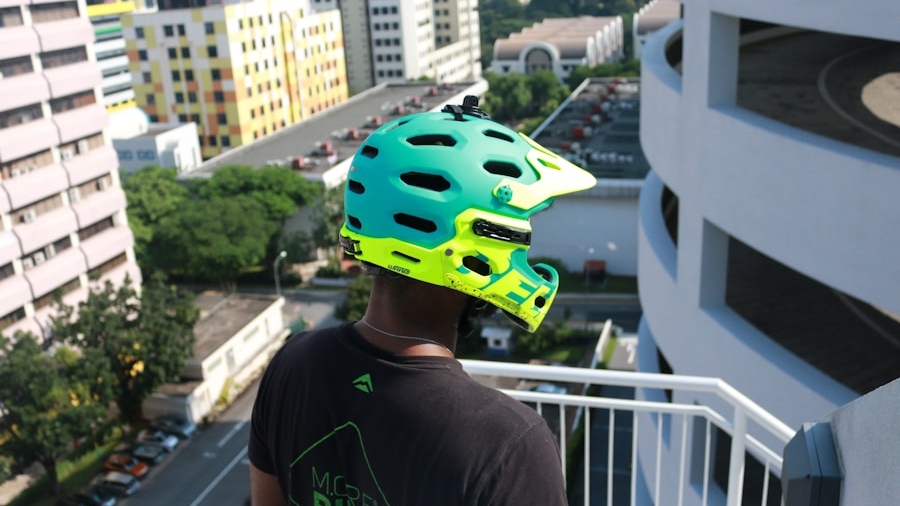In recent years, the industrial sector has witnessed a significant transformation driven by technological advancements. Among these innovations, smart helmets have emerged as a pivotal tool designed to enhance safety and efficiency in various industrial environments. These helmets are not merely protective headgear; they are sophisticated devices equipped with cutting-edge technology that integrates augmented reality (AR), sensors, and communication systems.
The evolution of smart helmets reflects a broader trend towards digitization and automation in industries such as construction, manufacturing, and mining, where the need for enhanced safety measures is paramount. Smart helmets are designed to address the unique challenges faced by industrial workers. They provide real-time data and analytics that can help prevent accidents and improve operational efficiency.
For instance, these helmets can monitor environmental conditions, detect hazardous materials, and even provide workers with critical information about their surroundings through heads-up displays.
Key Takeaways
- Smart helmets are revolutionizing safety in industrial settings by integrating advanced technology into traditional safety gear.
- Safety gear, including smart helmets, is crucial for protecting industrial workers from workplace hazards and reducing the risk of accidents and injuries.
- Smart helmets offer features such as real-time monitoring, communication capabilities, and augmented reality displays, providing numerous benefits for industrial workers and their employers.
- Smart helmets improve worker safety by enhancing situational awareness, providing vital information, and enabling quick response to potential dangers in the workplace.
- Case studies demonstrate the successful implementation of smart helmets in various industrial settings, showcasing their effectiveness in improving worker safety and productivity.
The Importance of Safety Gear for Industrial Workers
Safety gear is a fundamental component of workplace safety in industrial settings. The nature of industrial work often exposes employees to various hazards, including heavy machinery, toxic substances, and extreme environmental conditions. According to the Occupational Safety and Health Administration (OSHA), thousands of workplace injuries occur each year due to inadequate safety measures.
This underscores the necessity for effective personal protective equipment (PPE) that can mitigate risks and protect workers from potential harm. The importance of safety gear extends beyond mere compliance with regulations; it is a critical factor in fostering a culture of safety within organizations. When workers are equipped with appropriate safety gear, they are more likely to feel secure and confident in their roles.
This sense of security can lead to increased productivity and morale, as employees are less distracted by concerns about their safety. Moreover, investing in high-quality safety gear, such as smart helmets, demonstrates an organization’s commitment to the well-being of its workforce, which can enhance employee loyalty and retention.
Features and Benefits of Smart Helmets

Smart helmets come equipped with a variety of features that set them apart from traditional headgear. One of the most notable features is the integration of augmented reality technology, which allows workers to visualize critical information directly in their line of sight. This can include schematics, safety protocols, or real-time data about machinery performance.
By providing this information hands-free, smart helmets enable workers to maintain focus on their tasks while accessing essential data. In addition to AR capabilities, many smart helmets are outfitted with sensors that monitor environmental conditions such as temperature, humidity, and air quality. These sensors can alert workers to hazardous conditions, allowing them to take appropriate action before an incident occurs.
Furthermore, smart helmets often include communication systems that facilitate seamless interaction between team members, enhancing collaboration and coordination on the job site. The combination of these features not only improves safety but also boosts overall productivity by streamlining workflows and reducing downtime.
How Smart Helmets Improve Worker Safety
The implementation of smart helmets has a profound impact on worker safety in industrial settings. One of the primary ways these helmets enhance safety is through real-time monitoring and alerts. For example, if a worker enters an area with elevated levels of toxic gases, the helmet can provide immediate warnings through auditory or visual signals.
This proactive approach allows workers to respond swiftly to potential dangers, significantly reducing the likelihood of accidents. Moreover, smart helmets can facilitate remote assistance from experts who may not be physically present on-site. Through video streaming capabilities, workers can connect with specialists who can guide them through complex tasks or troubleshoot issues in real time.
This not only enhances safety by ensuring that workers have access to expert advice but also minimizes the risk of errors that could lead to accidents or equipment damage. By bridging the gap between on-site workers and remote experts, smart helmets create a safer working environment where help is always just a call away.
Case Studies: Successful Implementation of Smart Helmets in Industrial Settings
Several organizations have successfully integrated smart helmets into their operations, showcasing their effectiveness in enhancing safety and efficiency. One notable example is the construction industry giant Bechtel, which implemented smart helmets equipped with AR technology on various job sites. By using these helmets, workers were able to visualize project plans and blueprints directly in their field of view, reducing the need for paper plans and minimizing errors during construction.
The result was not only improved safety but also increased project efficiency and reduced costs. Another compelling case study comes from the mining sector, where companies like Rio Tinto have adopted smart helmets to enhance worker safety in challenging environments. These helmets are equipped with sensors that monitor environmental conditions such as gas levels and temperature fluctuations.
In one instance, a smart helmet alerted miners to rising carbon monoxide levels in a tunnel, prompting immediate evacuation and preventing potential health risks. This incident highlights how smart helmets can serve as a critical line of defense against hazardous conditions in high-risk industries.
Challenges and Limitations of Smart Helmets

Cost Prohibitive for Some Organizations
One significant limitation is the cost associated with these advanced devices. While prices have been decreasing as technology evolves, the initial investment for organizations can still be substantial. Smaller companies or those operating on tight budgets may find it difficult to justify the expense of outfitting their workforce with smart helmets when traditional safety gear may suffice.
Reliability and Durability Concerns
Additionally, there are concerns regarding the reliability and durability of smart helmets in harsh industrial environments. These devices must withstand extreme conditions such as dust, moisture, and impacts from heavy machinery. If not designed robustly enough, they may fail to function properly when needed most.
Learning Curve and Operational Disruption
Furthermore, there is a learning curve associated with new technology; workers may require training to effectively utilize all features of smart helmets, which can temporarily disrupt operations during the transition period.
Future Developments and Innovations in Smart Helmet Technology
The future of smart helmet technology holds exciting possibilities as advancements continue to emerge at a rapid pace. One area poised for growth is the integration of artificial intelligence (AI) into smart helmets. AI could enhance data analysis capabilities by providing predictive insights based on historical data trends.
For instance, AI algorithms could analyze environmental data collected by sensors to forecast potential hazards before they occur, allowing for preemptive measures to be taken. Moreover, advancements in battery technology could lead to longer-lasting power sources for smart helmets, addressing one of the current limitations regarding battery life during extended shifts. Wireless charging solutions may also become more prevalent, allowing for seamless recharging without interrupting workflow.
As 5G networks expand globally, smart helmets could leverage high-speed connectivity for real-time data sharing and communication among teams across vast job sites or even different geographical locations.
The Role of Smart Helmets in Protecting Industrial Workers
As industries continue to evolve in response to technological advancements, smart helmets represent a significant leap forward in worker safety and operational efficiency. By integrating features such as augmented reality, environmental monitoring, and real-time communication capabilities, these devices are transforming how industrial work is conducted. The successful implementation of smart helmets in various sectors demonstrates their potential to reduce accidents and enhance productivity.
While challenges remain regarding cost and durability, ongoing innovations promise to address these limitations and further solidify the role of smart helmets in protecting industrial workers. As organizations increasingly prioritize safety and efficiency in their operations, it is clear that smart helmets will play an essential role in shaping the future of workplace safety across industries worldwide.
In a recent article on the best free software for 3D modeling in 2023, the importance of utilizing cutting-edge technology in various industries is highlighted. Just like the role of smart helmets in protecting industrial workers, the use of advanced software can greatly enhance productivity and safety in the workplace. By staying up-to-date with the latest tools and technologies, companies can ensure the well-being of their employees while also improving efficiency and quality of work.
FAQs
What is a smart helmet?
A smart helmet is a type of protective headgear that is equipped with advanced technology such as sensors, cameras, communication systems, and augmented reality displays to enhance safety and productivity for industrial workers.
How do smart helmets protect industrial workers?
Smart helmets protect industrial workers by providing features such as impact detection, real-time monitoring of vital signs, hazard alerts, and communication capabilities to ensure their safety in hazardous work environments.
What are the benefits of using smart helmets in industrial settings?
The benefits of using smart helmets in industrial settings include improved safety, enhanced communication, real-time data collection, increased productivity, and the ability to provide immediate assistance in case of emergencies.
What industries can benefit from the use of smart helmets?
Industries such as construction, mining, manufacturing, oil and gas, utilities, and transportation can benefit from the use of smart helmets to protect workers from potential hazards and improve overall workplace safety.
Are there any regulations or standards for smart helmets in industrial workplaces?
Currently, there are no specific regulations or standards for smart helmets in industrial workplaces, but they are typically subject to the same safety regulations and standards as traditional protective headgear.
What are some examples of smart helmet features?
Some examples of smart helmet features include built-in cameras for recording and live streaming, heads-up displays for providing real-time information, communication systems for team collaboration, and sensors for detecting environmental hazards.

